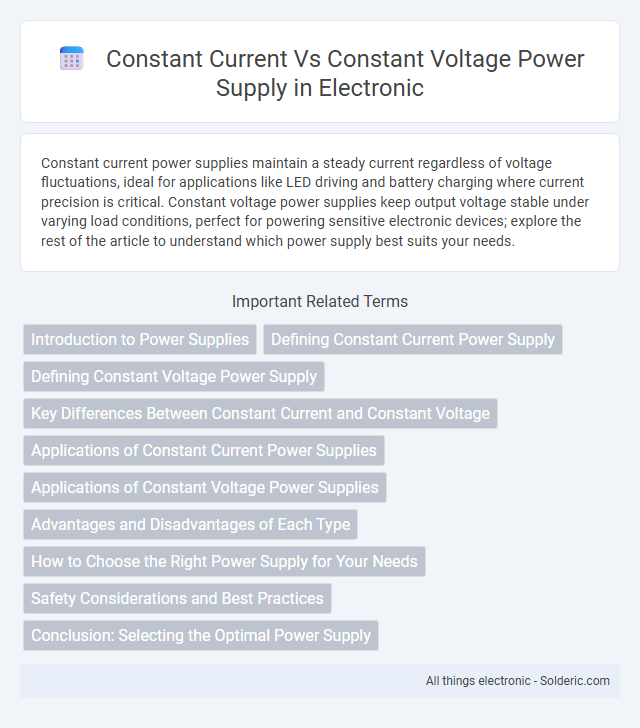Constant current power supplies maintain a steady current regardless of voltage fluctuations, ideal for applications like LED driving and battery charging where current precision is critical. Constant voltage power supplies keep output voltage stable under varying load conditions, perfect for powering sensitive electronic devices; explore the rest of the article to understand which power supply best suits your needs.
Comparison Table
| Feature | Constant Current (CC) Power Supply | Constant Voltage (CV) Power Supply |
|---|---|---|
| Primary Function | Maintains steady current output | Maintains steady voltage output |
| Typical Usage | LEDs, battery charging, laser diodes | Electronics testing, powering devices requiring fixed voltage |
| Output Regulation | Adjusts voltage to keep current constant | Adjusts current to keep voltage constant |
| Protection | Prevents overcurrent damage | Prevents overvoltage damage |
| Load Characteristics | Current remains fixed; voltage varies with load | Voltage remains fixed; current varies with load |
| Advantages | Ideal for current-sensitive devices, ensures device safety | Ideal for voltage-sensitive devices, stable voltage supply |
| Disadvantages | Voltage can fluctuate; not suitable for voltage-critical loads | Current can fluctuate; not suitable for current-critical loads |
Introduction to Power Supplies
Power supplies deliver electrical energy by regulating either current or voltage, essential for various electronic devices and applications. Constant current power supplies maintain a steady current regardless of voltage changes, ideal for LEDs and battery charging, while constant voltage power supplies provide a stable voltage output, critical for powering sensitive electronics. Understanding your device's requirements helps you select the appropriate power supply to ensure safety and optimal performance.
Defining Constant Current Power Supply
A constant current power supply delivers a steady current regardless of voltage fluctuations, ensuring precise control in applications like LED driving or battery charging. Unlike constant voltage power supplies that maintain fixed voltage, a constant current supply adjusts voltage to keep current stable, preventing damage to sensitive components. Your choice depends on whether your device requires regulated current flow or regulated voltage for optimal performance.
Defining Constant Voltage Power Supply
A constant voltage power supply maintains a fixed output voltage regardless of changes in load current, ensuring stable voltage delivery to electronic devices. This type of power supply is ideal for applications where voltage-sensitive components require consistent voltage to operate safely and efficiently. You benefit from precise voltage regulation that protects sensitive circuits from voltage fluctuations and ensures reliable performance.
Key Differences Between Constant Current and Constant Voltage
Constant current power supplies maintain a fixed current regardless of voltage fluctuations, ideal for applications like LED driving and battery charging where current stability is crucial. Constant voltage power supplies deliver a steady voltage output while allowing current to vary based on load demands, commonly used in powering electronic devices and circuits requiring stable voltage. The key difference lies in the control parameter: constant current regulates current output tightly, while constant voltage focuses on maintaining voltage stability.
Applications of Constant Current Power Supplies
Constant current power supplies are essential in applications requiring precise control of current, such as LED lighting, battery charging, and electroplating processes. These power supplies ensure stable current delivery regardless of voltage fluctuations, protecting sensitive components and enhancing overall system reliability. Your projects involving sensors or semiconductor testing will benefit from the consistent current output provided by these devices.
Applications of Constant Voltage Power Supplies
Constant voltage power supplies are predominantly used in applications requiring stable voltage regardless of load variations, such as LED lighting systems, battery charging, and telecommunications equipment. These supplies ensure consistent voltage levels, protecting sensitive electronic components and enhancing device performance. Their ability to maintain a fixed voltage output makes them ideal for powering circuits with varying current demands while preventing damage due to voltage fluctuations.
Advantages and Disadvantages of Each Type
Constant current power supplies excel in applications requiring precise current regulation, such as LED driving and battery charging, offering protection against current surges and enhancing device lifespan. However, their voltage output varies with load, potentially limiting use in voltage-sensitive circuits. Constant voltage power supplies provide stable voltage ideal for general electronics and communication devices but may cause damage if current limits are exceeded, requiring additional current limiting components for safety.
How to Choose the Right Power Supply for Your Needs
Choosing the right power supply depends on your device's requirements: constant current (CC) power supplies deliver a fixed current, ideal for applications like LED lighting and battery charging where current control prevents damage. Constant voltage (CV) power supplies maintain a stable voltage, perfect for electronics that require steady voltage input such as microcontrollers and sensors. Assess your load characteristics and determine whether controlling current or voltage is critical to optimize performance and safety for your project.
Safety Considerations and Best Practices
Constant current power supplies ensure safety by limiting the current to prevent overheating and component damage, making them ideal for LED and battery charging applications. Constant voltage power supplies maintain a fixed voltage to protect sensitive electronic devices from voltage spikes and fluctuations. To optimize your system's safety, always verify the power supply rating matches your load requirements and use proper fusing or circuit protection.
Conclusion: Selecting the Optimal Power Supply
Choosing the optimal power supply depends on your application requirements: constant current power supplies are ideal for LED lighting or battery charging where maintaining specific current levels prevents damage, while constant voltage power supplies suit devices needing stable voltage like sensors or microcontrollers. Efficiency, safety, and device specifications must guide your selection to ensure reliable and consistent performance. Matching your power supply type with your equipment's electrical demands ensures better longevity and optimal functionality.
constant current vs constant voltage power supply Infographic

 solderic.com
solderic.com